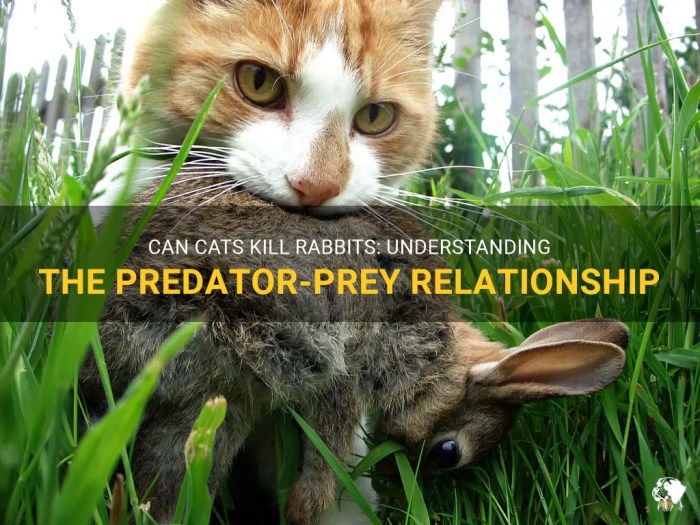Cats and rabbits are common household pets, but their relationship in the wild is far more complex. As natural predators, cats possess instincts that drive them to hunt and kill small animals like rabbits. In this comprehensive guide, we will delve into the fascinating interactions between these two species, exploring their hunting behaviors, physical characteristics, and the potential outcomes of their encounters.
Throughout history, cats have played a significant role in the ecosystem as predators, helping to control rodent populations. Their keen senses, agility, and sharp claws make them formidable hunters. On the other hand, rabbits have evolved various adaptations to evade predators, including their speed, agility, and ability to reproduce quickly.
Hunting Behavior of Cats
Cats possess an innate hunting instinct, honed over millions of years of evolution. As predators, they play a crucial role in maintaining ecological balance by controlling rodent populations.
Unlike many other predators, cats exhibit a unique hunting strategy. Their stealthy movements, sharp claws, and acute senses allow them to approach prey undetected. Once within striking distance, they launch a lightning-fast attack, delivering a powerful bite to the neck or head.
Solitary Hunters
Unlike wolves or lions that hunt in packs, cats are predominantly solitary hunters. This solitary nature allows them to avoid competition for prey and to optimize their hunting success in diverse environments.
Physical Characteristics of Rabbits
Rabbits possess several physical characteristics that render them vulnerable to feline predators. These include their relatively small size, limited agility, and comparatively low speed.
Size and Speed
Rabbits are typically smaller than cats, with most species weighing between 2 and 10 pounds. Their compact size makes them easier for cats to catch and subdue. Additionally, rabbits are not particularly fast runners, with an average speed of around 20 miles per hour.
This lack of speed makes it difficult for them to outrun pursuing cats.
Agility and Evasion
While rabbits can jump and maneuver quickly in short bursts, their overall agility is limited compared to cats. Cats are highly agile and can change direction and jump quickly, making it challenging for rabbits to evade them. Furthermore, rabbits’ lack of natural defenses, such as claws or sharp teeth, makes them more susceptible to attacks from predators.
Interactions Between Cats and Rabbits

Cats and rabbits are often kept as pets in close proximity, but their natural instincts can lead to conflicts. Interactions between these species can vary depending on the circumstances, but they can range from peaceful coexistence to aggressive attacks.Factors that influence the outcome of these interactions include the size, age, and temperament of both the cat and the rabbit, as well as the presence of other animals or people in the environment.
Generally, larger cats are more likely to view rabbits as prey, while smaller cats may be more curious or playful. Younger animals are also more likely to be aggressive than older ones, and rabbits that are not properly socialized may be more fearful or defensive.
Potential for Injury or Death
Cat attacks can cause serious injuries or even death to rabbits. Cats have sharp claws and teeth that can inflict deep wounds, and they may also transmit diseases to rabbits through their bites. Even if a cat does not intend to kill a rabbit, its playful behavior can still result in serious injuries.
For example, a cat may chase a rabbit, causing it to run into an obstacle and injure itself.
Prevention and Mitigation Strategies
Preventing cat attacks on rabbits and mitigating their risk are crucial for ensuring the well-being of both species. Here are some effective strategies:
Methods to Prevent Cat Attacks on Rabbits
| Method | Potential Effectiveness |
|---|---|
| Supervise interactions | High |
| Provide separate spaces | Moderate |
| Use deterrents (e.g., motion-activated sprinklers, ultrasonic devices) | Variable |
| Train cats to avoid rabbits | Low |
Actions for Rabbit Owners to Mitigate Risk
* House rabbits in secure hutches or enclosures
- Keep rabbits indoors when cats are present
- Monitor outdoor rabbits closely
- Remove potential hiding spots for cats
- Provide rabbits with escape routes
Responsible Pet Ownership and Ethical Treatment
Responsible pet ownership is essential for preventing cat attacks on rabbits. Owners should:* Spay or neuter cats to reduce territorial behavior
- Keep cats indoors to minimize hunting opportunities
- Provide cats with enrichment and exercise to reduce boredom and aggression
- Respect the rights and well-being of both cats and rabbits
Outcome Summary
Understanding the interactions between cats and rabbits is crucial for responsible pet ownership and the welfare of both species. By implementing prevention and mitigation strategies, such as supervised interactions, secure enclosures, and responsible pet care, we can minimize the risk of conflict and ensure the safety of our furry companions.
FAQ Summary
Can cats kill rabbits?
Yes, cats are natural predators and can kill rabbits, especially young, injured, or unsuspecting ones.
What factors influence the outcome of interactions between cats and rabbits?
Factors such as the size, age, and health of both animals, as well as the environment and presence of other predators, can influence the outcome of their encounters.
How can I prevent my cat from attacking my rabbit?
Supervised interactions, secure enclosures, and responsible pet ownership are effective ways to prevent cat attacks on rabbits.
What should I do if my cat attacks my rabbit?
If an attack occurs, separate the animals immediately and seek veterinary attention for the injured rabbit.